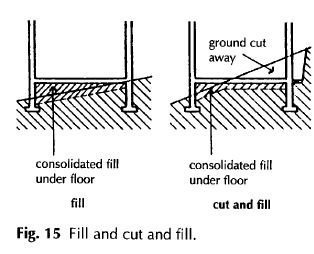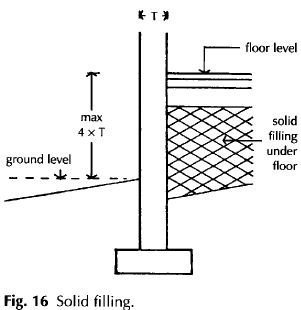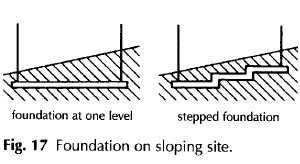The natural surface of ground is rarely level to the extent that there may be an appreciable slope either across or along or both across and along the site of most buildings.
On sloping sites an initial decision to be made is whether the ground floor is to be above ground at the highest point or partly sunk below ground as illustrated in Fig. 15.

Where the ground floor is to be at or just above ground level at the highest point, it is necessary to import some dry fill material such as broken brick or concrete hardcore to raise the level of the oversite concrete and floor. This fill will be placed, spread and consolidated up to the external wall once it has been built.
The consolidated fill will impose some horizontal pressure on the wall. To make sure that the stability of the wall is adequate to withstand this lateral pressure it is recommended practice that the thickness of the wall should be at least a quarter of the height of the fill bearing on it as illustrated in Fig. 16. The thickness of a cavity wall is taken as the combined thickness of the two leaves unless the cavity is filed with concrete when the overall thickness is taken.

To reduce the amount of fill necessary under solid floors on sloping sites a system of cut and fill may be used as illustrated in Fig. 15. The disadvantage of this arrangement is that the ground floor is below ground level at the highest point and it is necessary to form an excavated dry area to collect and drain surface water that would otherwise run up to the wall and cause problems of dampness.

To economise in excavation and foundation walling on sloping sites where the subsoil, such as gravel and sand, is compact it is practice to use a stepped foundation as illustrated in Fig. 17, which contrasts diagrammatically the reduction in excavation and foundation walling of a level and a stepped foundation.

Figure 18 is an illustration of the stepped foundation for a small building on a sloping site where the subsoil is reasonably compact near the surface and will not be affected by volume changes. The foundation is stepped up the slope to minimise excavation and walling below ground.
The foundation is stepped so that each step is no higher than the thickness of the concrete foundation and the foundation at the higher level overlaps the lower foundation by at least 300 mm.

The load bearing walls are raised and the foundation trenches around the walls backfilled with selected soil from the excavation. The concrete oversite and solid ground floor may be cast on granular fill no more than 600 mm deep or cast or placed as a suspended reinforced concrete slab. The drains shown at the
back of the trench fill are laid to collect and drain water to the sides of the building.